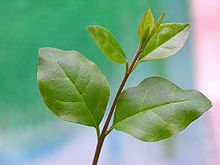| Revision as of 11:29, 7 May 2015 edit108.193.69.105 (talk) →Cultivation and uses← Previous edit | Revision as of 07:10, 2 February 2017 edit undoNurg (talk | contribs)Extended confirmed users, Page movers, Pending changes reviewers, Rollbackers62,250 edits s.a. Privet as an invasive plantNext edit → | ||
| Line 37: | Line 37: | ||
| It was introduced to North America to be used for hedges and landscaping where it has now escaped from cultivation and is listed as an ] in southeastern states.<ref name=usda>USDA Plants Profile: </ref><ref>{{cite book |url=http://www.nps.gov/plants/alien/pubs/midatlantic/midatlantic.pdf | title=Plant Invaders of Mid-Atlantic Natural Areas, 4th Edition |last1=Swearingen |first1=Jil |last2=Reshetiloff |first2=K. |last3=Slattery |first3=B |last4=Zwicker |first4=S. | year=2010 |publisher=National Park Service and U.S. Fish & Wildlife Service |page=71}} This reference lists ''L. vulgare'', ''L. obtusifolium'', ''L. ovalifolium'', and ''L. sinense'' as invasive.</ref> It is estimated that Chinese privet now occupies over one million hectares of land across 12 states ranging from ] to ] and west to ], with detrimental effects to biodiversity and forest health.<ref name=hanula>Hanula, J.L, Horn, S., Taylor, J.W. (2009). Chinese Privet (''Ligustrum sinense'') Removal and its Effect on Native Plant Communities of Riparian Forests. Invasive Plant Science and Management 2:292-300. {{doi|10.1614/IPSM-09-028.1}}</ref> {{clear|left}} | It was introduced to North America to be used for hedges and landscaping where it has now escaped from cultivation and is listed as an ] in southeastern states.<ref name=usda>USDA Plants Profile: </ref><ref>{{cite book |url=http://www.nps.gov/plants/alien/pubs/midatlantic/midatlantic.pdf | title=Plant Invaders of Mid-Atlantic Natural Areas, 4th Edition |last1=Swearingen |first1=Jil |last2=Reshetiloff |first2=K. |last3=Slattery |first3=B |last4=Zwicker |first4=S. | year=2010 |publisher=National Park Service and U.S. Fish & Wildlife Service |page=71}} This reference lists ''L. vulgare'', ''L. obtusifolium'', ''L. ovalifolium'', and ''L. sinense'' as invasive.</ref> It is estimated that Chinese privet now occupies over one million hectares of land across 12 states ranging from ] to ] and west to ], with detrimental effects to biodiversity and forest health.<ref name=hanula>Hanula, J.L, Horn, S., Taylor, J.W. (2009). Chinese Privet (''Ligustrum sinense'') Removal and its Effect on Native Plant Communities of Riparian Forests. Invasive Plant Science and Management 2:292-300. {{doi|10.1614/IPSM-09-028.1}}</ref> {{clear|left}} | ||
| ==See also== | |||
| *] | |||
| ==References== | ==References== | ||
Revision as of 07:10, 2 February 2017
| Chinese privet | |
|---|---|

| |
| Scientific classification | |
| Kingdom: | Plantae |
| (unranked): | Angiosperms |
| (unranked): | Eudicots |
| (unranked): | Asterids |
| Order: | Lamiales |
| Family: | Oleaceae |
| Tribe: | Oleeae |
| Genus: | Ligustrum |
| Species: | L. sinense |
| Binomial name | |
| Ligustrum sinense Lour. | |
Ligustrum sinense (Chinese privet; syn. L. villosum; in Mandarin: 杻; pinyin: chǒu) is a species of privet native to China, Taiwan and Vietnam. It is also naturalized in Réunion, the Andaman Islands, Norfolk Island, Costa Rica, Honduras, Panamá and much of the eastern and southern United States (from Texas and Florida north to Kansas, Illinois, New Jersey, Massachusetts and Connecticut). Ligustrum lucidum is sometimes also called "Chinese privet".
Ligustrum sinense is an deciduous shrub growing to 2–7 m tall, with densely hairy shoots. The leaves are opposite, 2–7 cm long and 1–3 cm broad, rarely larger, with an entire margin and a 2–8 mm petiole. The flowers are white, with a four-lobed corolla 3.5–5.5 mm long. The fruit is subglobose, 5–8 mm diameter.
The following varieties are accepted by the Flora of China:
- Ligustrum sinense var. sinense
- Ligustrum sinense var. concavum M.C.Chang
- Ligustrum sinense var. coryanum (W.W.Sm.) Hand.-Mazz.
- Ligustrum sinense var. dissimile S.J.Hao
- Ligustrum sinense var. luodianense M.C.Chang
- Ligustrum sinense var. myrianthum (Diels) Hoefker
- Ligustrum sinense var. opienense Y.C.Yang
- Ligustrum sinense var. rugosulum (W.W.Sm.) M.C.Chang
Cultivation and uses

It is cultivated as an ornamental plant and for hedges. Several cultivars have been selected, including the very floriferous 'Multiflorum', the variegated cultivar 'Variegatum', and the dwarf cultivar 'Wimbei' growing to 0.5 m and with leaves only 6 mm long.
It has also been used as a popular bonsai tree.
It was introduced to North America to be used for hedges and landscaping where it has now escaped from cultivation and is listed as an invasive plant in southeastern states. It is estimated that Chinese privet now occupies over one million hectares of land across 12 states ranging from Virginia to Florida and west to Texas, with detrimental effects to biodiversity and forest health.
See also
References
- ^ USDA Plants Profile: Ligustrum sinense
- ^ Flora of China: Ligustrum sinense
- Kew World Checklist of Selected Plant Families, Ligustrum sinense
- Biota of North America Program, Ligustrum sinense
- Loureiro, João de. 1790. Flora cochinchinensis: sistens plantas in regno Cochinchina nascentes. Quibus accedunt aliæ observatæ in Sinensi imperio, Africa Orientali, Indiæque locis variis. Omnes dispositæ secundum systema sexuale Linnæanum. Ulyssipone. 1: 19. Ligustrum sinense
- Huxley, A., ed. (1992). New RHS Dictionary of Gardening. Macmillan ISBN 0-333-47494-5.
- Swearingen, Jil; Reshetiloff, K.; Slattery, B; Zwicker, S. (2010). Plant Invaders of Mid-Atlantic Natural Areas, 4th Edition (PDF). National Park Service and U.S. Fish & Wildlife Service. p. 71. This reference lists L. vulgare, L. obtusifolium, L. ovalifolium, and L. sinense as invasive.
- Hanula, J.L, Horn, S., Taylor, J.W. (2009). Chinese Privet (Ligustrum sinense) Removal and its Effect on Native Plant Communities of Riparian Forests. Invasive Plant Science and Management 2:292-300. doi:10.1614/IPSM-09-028.1